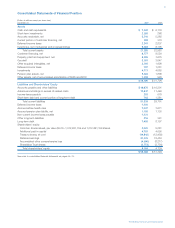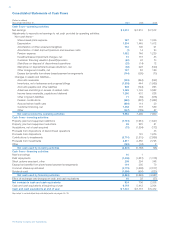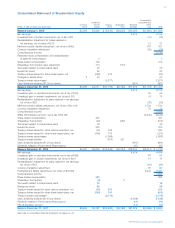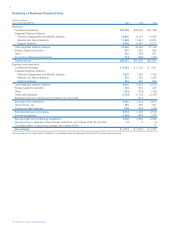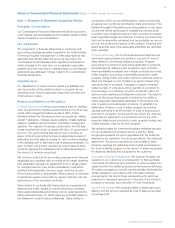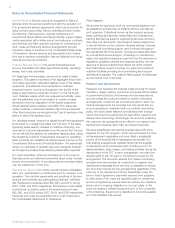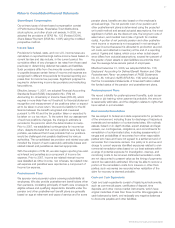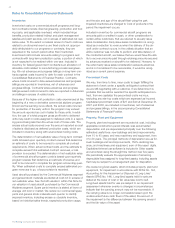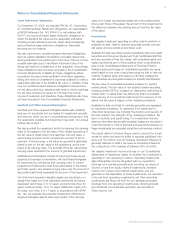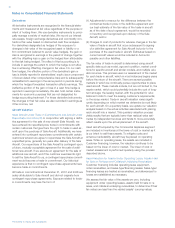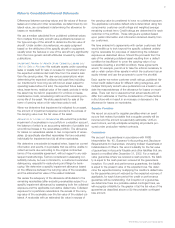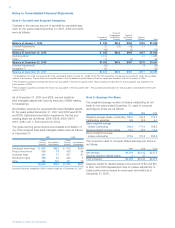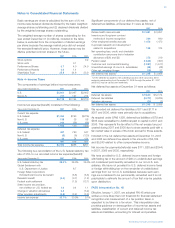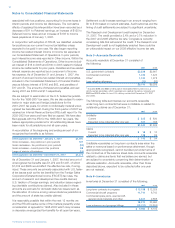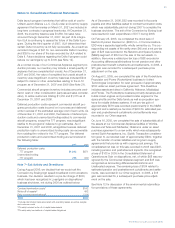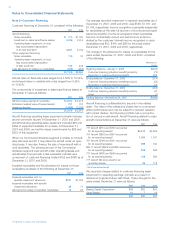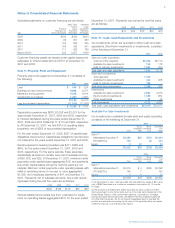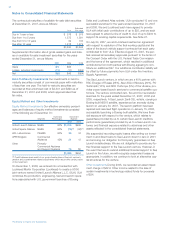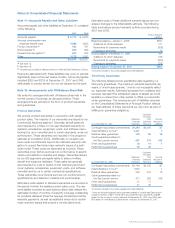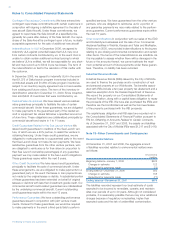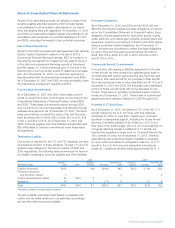Boeing 2007 Annual Report Download - page 54
Download and view the complete annual report
Please find page 54 of the 2007 Boeing annual report below. You can navigate through the pages in the report by either clicking on the pages listed below, or by using the keyword search tool below to find specific information within the annual report.51
Notes to Consolidated Financial Statements
Differences between carrying values and fair values of finance
leases and notes and other receivables, as determined by col-
lateral value, are considered in determining the allowance for
losses on receivables.
We use a median calculated from published collateral values
from multiple third-party aircraft value publications based on
the type and age of the aircraft to determine the fair value of
aircraft. Under certain circumstances, we apply judgment
based on the attributes of the specific aircraft or equipment,
usually when the features or use of the aircraft vary significantly
from the more generic aircraft attributes covered by outside
publications.
Impairment Review for Assets Under Operating Leases and
Held for Sale or Re-lease We evaluate assets under operating
lease or assets held for sale or re-lease for impairment when
the expected undiscounted cash flow from the asset is less
than the carrying value. We use various assumptions when
determining the expected undiscounted cash flow including
our intentions for how long we will hold an asset subject to
operating lease before it is sold, the expected future lease
rates, lease terms, residual value of the asset, periods in which
the asset may be held in preparation for a follow-on lease,
maintenance costs, remarketing costs and the remaining eco-
nomic life of the asset. We state assets held for sale at the
lower of carrying value or fair value less costs to sell.
When we determine that impairment is indicated for an asset,
the amount of impairment expense recorded is the excess of
the carrying value over the fair value of the asset.
Allowance for Losses on Receivables We record the potential
impairment of receivables in our portfolio in a valuation account,
the balance of which is an accounting estimate of probable but
unconfirmed losses in the receivables portfolio. The allowance
for losses on receivables relates to two components of receiv-
ables: (a) specifically identified receivables that are evaluated
individually for impairment and (b) all other receivables.
We determine a receivable is impaired when, based on current
information and events, it is probable that we will be unable to
collect amounts due according to the original contractual
terms of the receivable agreement, without regard to any sub-
sequent restructurings. Factors considered in assessing col-
lectibility include, but are not limited to, a customer’s extended
delinquency, requests for restructuring and filings for bank-
ruptcy. We determine a specific impairment allowance based
on the difference between the carrying value of the receivable
and the estimated fair value of the related collateral.
We review the adequacy of the allowance attributable to the
remaining receivables (after excluding receivables subject to a
specific impairment allowance) by assessing both the collateral
exposure and the applicable cumulative default rate. Collateral
exposure for a particular receivable is the excess of the carry-
ing value of the receivable over the fair value of the related col-
lateral. A receivable with an estimated fair value in excess of
the carrying value is considered to have no collateral exposure.
The applicable cumulative default rate is determined using two
components: customer credit ratings and weighted average
remaining contract term. Credit ratings are determined for each
customer in the portfolio. Those ratings are updated based
upon public information and information obtained directly from
our customers.
We have entered into agreements with certain customers that
would entitle us to look beyond the specific collateral underly-
ing the receivable for purposes of determining the collateral
exposure as described above. Should the proceeds from the
sale of the underlying collateral asset resulting from a default
condition be insufficient to cover the carrying value of our
receivable (creating a shortfall condition), these agreements
would, for example, permit us to take the actions necessary to
sell or retain certain other assets in which the customer has an
equity interest and use the proceeds to cover the shortfall.
Each quarter we review customer credit ratings, published his-
torical credit default rates for different rating categories, and
multiple third party aircraft value publications as a basis to vali-
date the reasonableness of the allowance for losses on receiv-
ables. There can be no assurance that actual results will not
differ from estimates or that the consideration of these factors
in the future will not result in an increase or decrease to the
allowance for losses on receivables.
Supplier Penalties
We record an accrual for supplier penalties when an event
occurs that makes it probable that a supplier penalty will be
incurred and the amount is reasonably estimable. Until an
event occurs, we fully anticipate accepting all products pro-
cured under production-related contracts.
Guarantees
We account for guarantees in accordance with FASB
Interpretation No. 45, Guarantor’s Accounting and Disclosure
Requirements for Guarantees, Including Indirect Guarantees of
Indebtedness of Others. We record a liability for the fair value
of guarantees in Accounts Payable and other liabilities that are
issued or modified after December 31, 2002. For a residual
value guarantee where we received a cash premium, the liabili-
ty is equal to the cash premium received at the guarantee’s
inception. For credit and performance guarantees, the liability
is equal to the present value of the expected loss. We deter-
mine the expected loss by multiplying the creditor’s default rate
by the guarantee amount reduced by the expected recovery, if
applicable, for each future period the credit or performance
guarantee will be outstanding. If at inception of a guarantee,
we determine there is a probable related contingent loss, we
will recognize a liability for the greater of (a) the fair value of the
guarantee as described above or (b) the probable contingent
loss amount.
The Boeing Company and Subsidiaries


